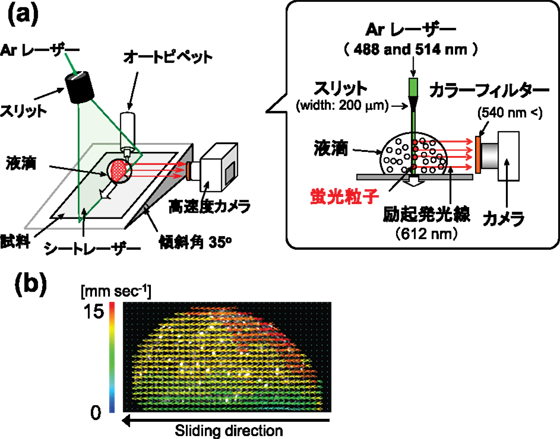All issues

Predecessor
Volume 84, Issue 11
Displaying 1-5 of 5 articles from this issue
- |<
- <
- 1
- >
- >|
Original Research Paper
-
Eri KODAMA, Motomi ONODERA, Hideaki HARIMA, Yoshikuni UCHIDA, Kazunori ...2011 Volume 84 Issue 11 Pages 369-372
Published: November 20, 2011
Released on J-STAGE: February 20, 2012
JOURNAL FREE ACCESSCatalytic polymerization of aniline was carried out in sol-gel silicas doped with aniline and copper(II) salts as a catalyst in order to prepare polyaniline/silica hybrid gels. Aqueous solutions of aniline, sodium dodecyl sulfate, HCl, Cu(II) salts and tetraethoxysilane were mixed and stirred at room temperature. The obtained gels showed a deep green color during the drying process and had absorption peaks at ∼422 nm and ∼750 nm, thus indicating the formation of emeraldine salts type polyaniline in the sol-gel silicas. As for the formation of polyaniline, CuCl2 was twice as active as CuSO4 or Cu(NO3)2. It was confirmed that polymerization of polyaniline proceeds by utilizing copper(II) salts as a catalyst and oxygen as an oxidant in the sol-gel silica gels. Fig. 1 Fullsize ImageView full abstractDownload PDF (918K)
Fig. 1 Fullsize ImageView full abstractDownload PDF (918K)
Current Topics
-
Tsutomu FURUTA, Akira NAKAJIMA2011 Volume 84 Issue 11 Pages 373-379
Published: November 20, 2011
Released on J-STAGE: February 20, 2012
JOURNAL FREE ACCESSTechnologies of hydrophobic coating on solid surface have been applied to various industrial items for droplet formation and removal from solid surfaces. However, for such surfaces, excellent water shedding properties and droplet control in a desired direction are not easily attainable unless detailed understandings on the relation between solid characteristics (such as structure, chemical composition, and their arrangement) and static/dynamic hydrophobicity. Recent researches revealed that static and dynamic liquid droplet behaviors are affected by nano-scale surface characteristics on hydrophobic solids, and the importance of the viewpoint from materials science is gradually increasing in this topic. This paper presents a review of recent studies, mainly of the past decade of our group, investigating the relation between solid characteristics and static/dynamic hydrophobicity. Fig. 2 Fullsize ImageView full abstractDownload PDF (1112K)
Fig. 2 Fullsize ImageView full abstractDownload PDF (1112K)
Serial Lecture
-
Naru HIGETA2011 Volume 84 Issue 11 Pages 380-385
Published: November 20, 2011
Released on J-STAGE: February 20, 2012
JOURNAL FREE ACCESSThe paint consists of many materials in order to realize various characteristics required by customers, which makes its analysis more difficult. The understanding of degradation mechanism and phenomena are very important for predicting the product life time. There are many methods to analyze the paints and coatings such as composition analysis, physical property analysis, environmental analysis, impurity analysis and degradation analysis. In this chapter, various analytical examples of the paints and coatings are introduced.View full abstractDownload PDF (1564K)
Serial Lecture
-
Hiroshi FUKUI2011 Volume 84 Issue 11 Pages 386-392
Published: November 20, 2011
Released on J-STAGE: February 20, 2012
JOURNAL FREE ACCESSNew products with unprecedented functions are expected in various industrial fields. Surface treatment is one of the important technologies to make the original products. In the case of the surface treatment of powders, it is necessary to grasp not only bulk, but also particle and surface properties. First, this paper describes the nature of particles and surface properties of powders, and then surface treatments of powders are explained. Furthermore, nano-coating of polymethylsiloxane (PMS) with tetramethylcyclotetrasiloxane by chemical vapor deposition on the powders, and the addition reaction of unsaturated compounds to Si-H groups of PMS film, so-called “functional nano-coating” is also described.View full abstractDownload PDF (1304K)
Serial Lecture
-
Kenji OZAKI2011 Volume 84 Issue 11 Pages 393-397
Published: November 20, 2011
Released on J-STAGE: February 20, 2012
JOURNAL FREE ACCESSOffset presses have been printing most of commercials, books and packaging so far. Along with the influence of recession and rising of e-Publishing, printing business circumstances is changing rapidly. In the early 1990's, a high speed run was the first priority, but recently extensive automation options which reduce waste, shorten makeready time and lower staff expenditure have been more highlighted. Thus, demands for smaller production runs, quick delivery and costdown became now first priority. In this article, basic principle of the offset printing is described.View full abstractDownload PDF (971K)
- |<
- <
- 1
- >
- >|